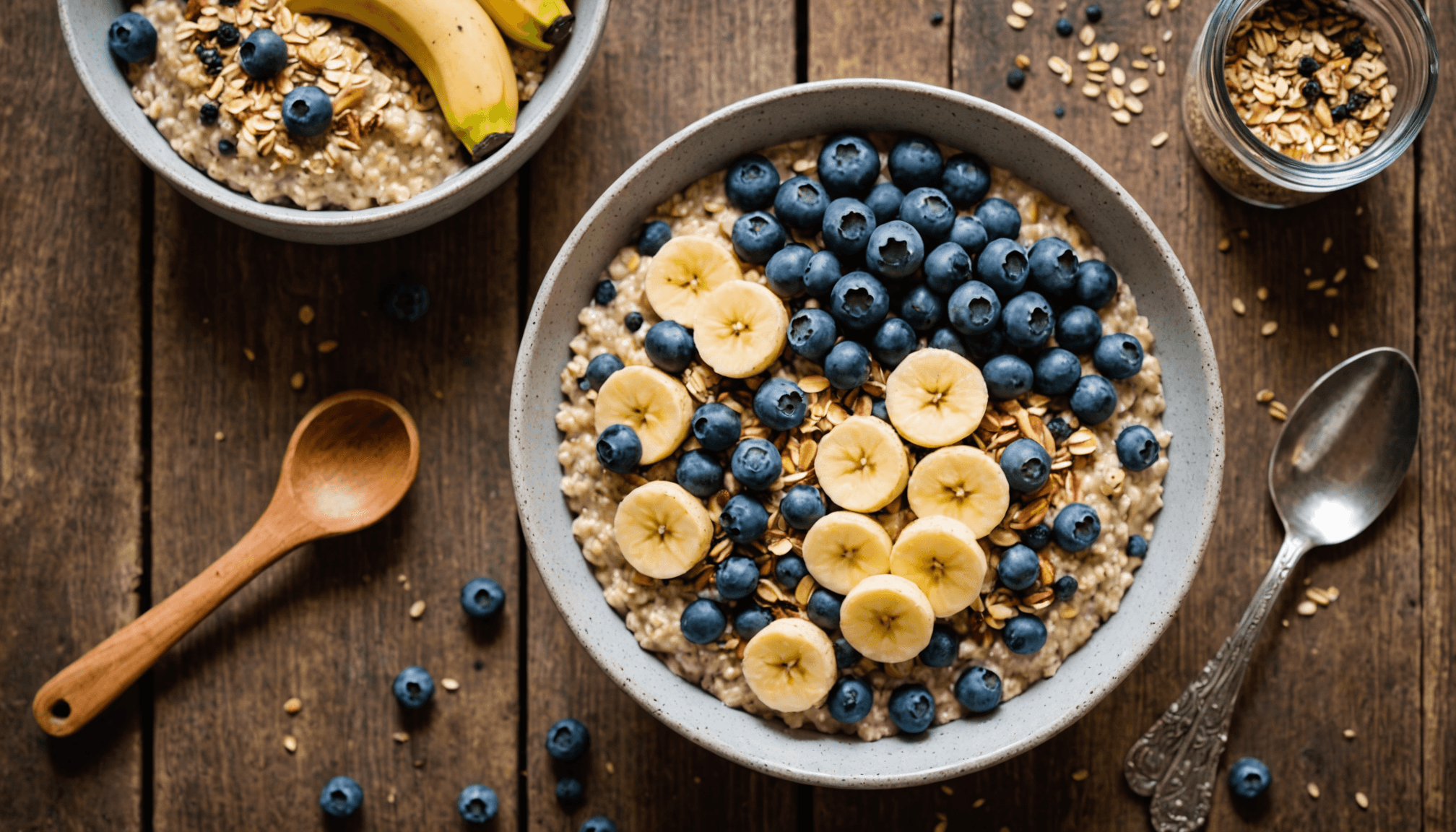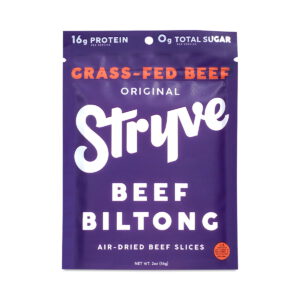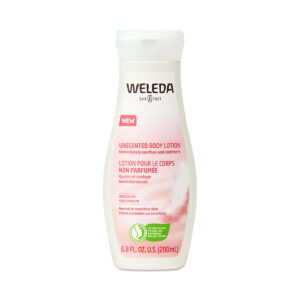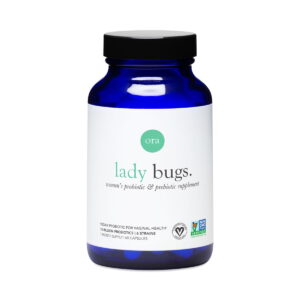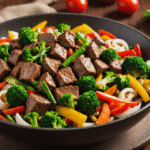- Understanding Inflammation and Its Effects
- Key Ingredients for Anti-Inflammatory Meals
- Breakfast Recipes to Start Your Day Right
- Nourishing Lunch Options for Sustained Energy
- Hearty Dinner Ideas for the Whole Family
- Light Snacks and Desserts to Satisfy Cravings
When it comes to grocery shopping, the choices you make can significantly impact your health and wellness, especially in the context of inflammation and clean eating. Here’s a treasure trove of practical advice to help you navigate both online and offline shopping experiences for your anti-inflammatory meal preparations.
First, consider shopping at local farmers’ markets, where you can find fresh, organic produce at reasonable prices. Not only will you support local farmers, but you’ll also gain access to seasonal fruits and vegetables that are generally more nutrient-dense. Be sure to ask questions about their farming practices to ensure you’re buying truly organic products.
When shopping online, choose reputable sites known for their organic offerings. Look for certifications like USDA Organic or Non-GMO Project Verified. Always read the product descriptions thoroughly to ensure you make informed choices about your food. Checking customer reviews can also offer insights into the quality and taste of the products.
Budget-friendly grocery shopping doesn’t have to mean sacrificing quality. Here are a few tips to keep costs down while maintaining an emphasis on clean eating:
- Buy in bulk: Items like grains, legumes, and spices are often cheaper when purchased in larger quantities.
- Plan your meals: Creating a weekly meal plan can help reduce impulse buys and ensure you utilize your groceries efficiently.
- Seasonal shopping: Choosing fruits and vegetables that are in-season usually results in cost savings and superior flavor.
When it comes to organic foods, it’s essential to prioritize certain products. The Environmental Working Group’s list of “Dirty Dozen” includes items that are known to have higher pesticide residues. Consider investing in organic options for these foods, such as strawberries, spinach, and apples.
For those focusing on fitness, consider incorporating foods rich in omega-3 fatty acids, antioxidants, and fiber into your shopping list. Look for items such as:
- Chia seeds
- Flaxseeds
- Walnuts
- Berries (blueberries, raspberries)
- Leafy greens (kale, spinach)
Additionally, ensure the safety of your groceries both online and in-store. When shopping online, look for secure payment options and check if the website has clear return policies and customer service options. When shopping in-store, sanitize your hands after handling products and before eating. Opt for packages that are sealed and free from any damages, as this can help you avoid potentially harmful contaminants.
By taking these proactive steps during your grocery shopping, you’ll be well-equipped to create nutrient-packed, anti-inflammatory meals that not only nourish your body but also delight your taste buds.
Key Ingredients for Anti-Inflammatory Meals
Incorporating key ingredients into your meals is vital for promoting an anti-inflammatory response in the body. A focus on certain foods can help reduce chronic inflammation and provide essential nutrients that support overall health. Below is a breakdown of some of the most effective ingredients known for their anti-inflammatory benefits.
First and foremost, fatty fish like salmon, mackerel, and sardines are exceptional sources of omega-3 fatty acids. These healthy fats have been shown to reduce the production of molecules and substances linked to inflammation, including inflammatory eicosanoids and cytokines. For those who prefer plant-based options, flaxseeds, chia seeds, and walnuts serve as excellent alternatives, offering a rich dose of ALA (alpha-linolenic acid), a type of omega-3.
Next, berries such as blueberries, strawberries, and blackberries are high in antioxidants, specifically flavonoids, which can help reduce inflammation and oxidative stress in the body. Their vibrant colors indicate a wealth of phytonutrients that contribute to combatting harmful free radicals. Including a variety of berries in your daily diet not only adds natural sweetness but also packs a nutritional punch.
Leafy greens are also pivotal components of anti-inflammatory meals. Vegetables like spinach, kale, and Swiss chard are rich in vitamins, minerals, and phytochemicals that foster an overall healthy immune response. They provide fiber and antioxidants that help to clean the gut, ensuring that the body functions optimally and reducing inflammation markers.
Another essential ingredient is turmeric, which contains curcumin, a powerful compound with potent anti-inflammatory properties. Research has shown that curcumin can inhibit various inflammatory pathways and reduce markers of inflammation such as CRP (C-reactive protein). Adding turmeric to your meals can enhance flavor as well as health benefits. It is often best combined with black pepper, which enhances the absorption of curcumin in the body.
Garlic is another powerful ally in fighting inflammation. It contains sulfur compounds that have been shown to lower the levels of certain inflammatory markers. Adding fresh garlic to your meals not only boosts flavor but contributes to heart health and overall immune function.
Finally, whole grains such as quinoa, brown rice, and oats are beneficial for maintaining healthy levels of inflammation. They have higher fiber content compared to refined grains, which is essential for a clean eating approach. The fiber in whole grains helps maintain a healthy gut microbiome, which plays a significant role in regulating inflammation.
To illustrate the benefits and nutritional profiles of these key ingredients, refer to the table below:
| Ingredient | Key Nutrients | Anti-Inflammatory Properties |
|---|---|---|
| Fatty Fish (Salmon, Mackerel) | Omega-3 Fatty Acids | Reduces inflammatory eicosanoids |
| Berries (Blueberries, Strawberries) | Flavonoids, Antioxidants | Reduces oxidative stress |
| Leafy Greens (Spinach, Kale) | Vitamins A, C, K, Fiber | Supports immune function |
| Turmeric | Curcumin | Inhibits inflammatory pathways |
| Garlic | Sulfur Compounds, Antioxidants | Reduces CRP levels |
| Whole Grains (Oats, Quinoa) | Fiber, B Vitamins | Maintains gut health |
By focusing on these key ingredients when planning your meals, you’ll not only be creating delicious organic meals but also fostering an environment that promotes health by mitigating the effects of inflammation. Each of these ingredients carries unique properties that can work synergistically for better overall health and a reduced inflammatory response, making them staples in your anti-inflammatory diet.
Breakfast Recipes to Start Your Day Right

Breakfast is often hailed as the most important meal of the day, and for good reason! Starting your day with anti-inflammatory foods can set a positive tone for how your body feels and functions throughout the day. When it comes to grocery shopping for healthy breakfast options, consider incorporating these practical tips to ensure that your morning meals are both nourishing and delicious.
Begin by looking for whole grains, which are essential for a clean eating approach. Items like oatmeal, whole grain bread, or quinoa can be excellent bases for your breakfast. When shopping, choose organic varieties whenever possible to minimize exposure to pesticides. If you’re purchasing oats, opt for steel-cut or rolled oats over instant varieties, as the latter can often contain added sugars and preservatives.
- Oats: High in fiber and great for reducing inflammation.
- Chia seeds: These tiny seeds are a powerhouse of omega-3 fatty acids and are perfect for overnight oats or smoothies.
- Colorful fruits: Berries, bananas, and apples add natural sweetness and are packed with antioxidants.
Don’t forget to stock up on healthy fats. Avocados are not only rich in heart-healthy monounsaturated fats but also offer anti-inflammatory benefits. Spread some on your toast or blend them into a smoothie for a creamy texture. Nuts and seeds, like walnuts and flaxseeds, are another great addition, providing omega-3s that help combat inflammation while also adding crunch to your meals.
When it comes to fruits, choose local and organic options when available. Seasonal fruits tend to be fresher and more nutrient-rich. For instance, berries such as blueberries and strawberries are excellent choices as they are high in flavonoids, which are powerful anti-inflammatory agents. If fresh berries aren’t available, consider buying frozen ones—they pack just as much nutritional punch and are often less expensive.
- Blueberries: Known to reduce inflammation and rich in antioxidants.
- Bananas: A great source of potassium and easy to grab on busy mornings.
- Apples: High in fiber and convenient for a quick breakfast or snack.
For those leaning toward vegan options, plant-based protein sources are a must. Items like almond milk or soy yogurt can be great for smoothies or as a dairy alternative in breakfast bowls. When shopping, look for unsweetened varieties to keep added sugars to a minimum. A sprinkle of cinnamon can also enhance flavor while supporting blood sugar control.
Online grocery shopping has its perks, especially for those with limited time. Use user reviews and ratings to guide your choices, particularly for brand selections or when trying a new product. Make sure to check for organic certifications when purchasing pantry staples online, such as oats and nut butters, to ensure you’re getting clean, high-quality ingredients.
Additionally, always review the shipping and handling policies for perishable items if you’re ordering from an online grocery store. If they don’t guarantee freshness or provide insulation during shipping, it may be best to look for alternatives.
Take some time to explore new recipes that spotlight these ingredients! For example, a delicious oatmeal bowl topped with berries, nuts, and a drizzle of honey can be not only satisfying but also a fantastic start to your day, fighting inflammation and promoting overall wellness.
Nourishing Lunch Options for Sustained Energy
 Nourishing your body during lunchtime with anti-inflammatory organic meals can provide the sustained energy necessary for an active day. Focusing on whole foods that are rich in nutrients not only helps to keep inflammation at bay but also ensures you maintain your energy levels throughout the afternoon.
Nourishing your body during lunchtime with anti-inflammatory organic meals can provide the sustained energy necessary for an active day. Focusing on whole foods that are rich in nutrients not only helps to keep inflammation at bay but also ensures you maintain your energy levels throughout the afternoon.
A fantastic option is a vibrant quinoa salad packed with seasonal vegetables and a zesty dressing. Quinoa is not only a complete protein but also an excellent source of fiber, which aids digestion. Combine cooked quinoa with chopped cucumbers, bell peppers, cherry tomatoes, and red onion for a crunch. Toss in a handful of fresh spinach or kale for added greens, then drizzle with a dressing made from olive oil, lemon juice, and a sprinkle of turmeric to maximize its anti-inflammatory benefits.
Another stellar lunch idea is a hearty vegetable stir-fry. Use a variety of colorful vegetables like broccoli, carrots, and snap peas, which are rich in vitamins and minerals. Sauté them in sesame oil and add a protein source such as tofu or chicken. Incorporating garlic and ginger can enhance both flavor and health benefits, as both are known for their anti-inflammatory properties. Serve your stir-fry over brown rice or whole grain noodles for a nutritious and filling meal.
For those who prefer wraps, consider using whole wheat or spinach tortillas. Fill them with hummus, sliced avocado, and an array of veggies, such as shredded carrots, spinach, and bell peppers. This combination not only delivers a hearty dose of anti-inflammatory ingredients but also keeps your meal light yet satisfying. To add a punch of flavor, consider a sprinkle of cumin or smoked paprika, both of which carry health benefits along with magnificent taste.
Soup is another comforting option for lunch that can be easily made in large batches for meal prep. A creamy sweet potato and coconut milk soup can be both energizing and anti-inflammatory, thanks to the beta-carotene in sweet potatoes and the healthy fats from coconut milk. Blend cooked sweet potatoes with coconut milk, ginger, and vegetable broth until smooth. Season with garlic, turmeric, and black pepper for a warming, nutritious meal.
Don’t overlook the power of legumes, either. Chickpeas can be transformed into a delicious salad combined with diced red onion, parsley, and a lemon-tahini dressing. They are a great plant-based protein source and packed with fiber, promoting a healthy gut and reducing inflammation.
Lastly, stay hydrated and consider including herbal teas as an accompaniment to your lunch. Green tea, in particular, is filled with antioxidants and can amplify your body’s ability to fight inflammation.
Incorporating these flavorful, nutritious lunches into your daily routine not only satisfies your hunger but also sets the stage for a productive afternoon while combating inflammation naturally.
“Let food be thy medicine, and medicine be thy food.” – Hippocrates
Hearty Dinner Ideas for the Whole Family
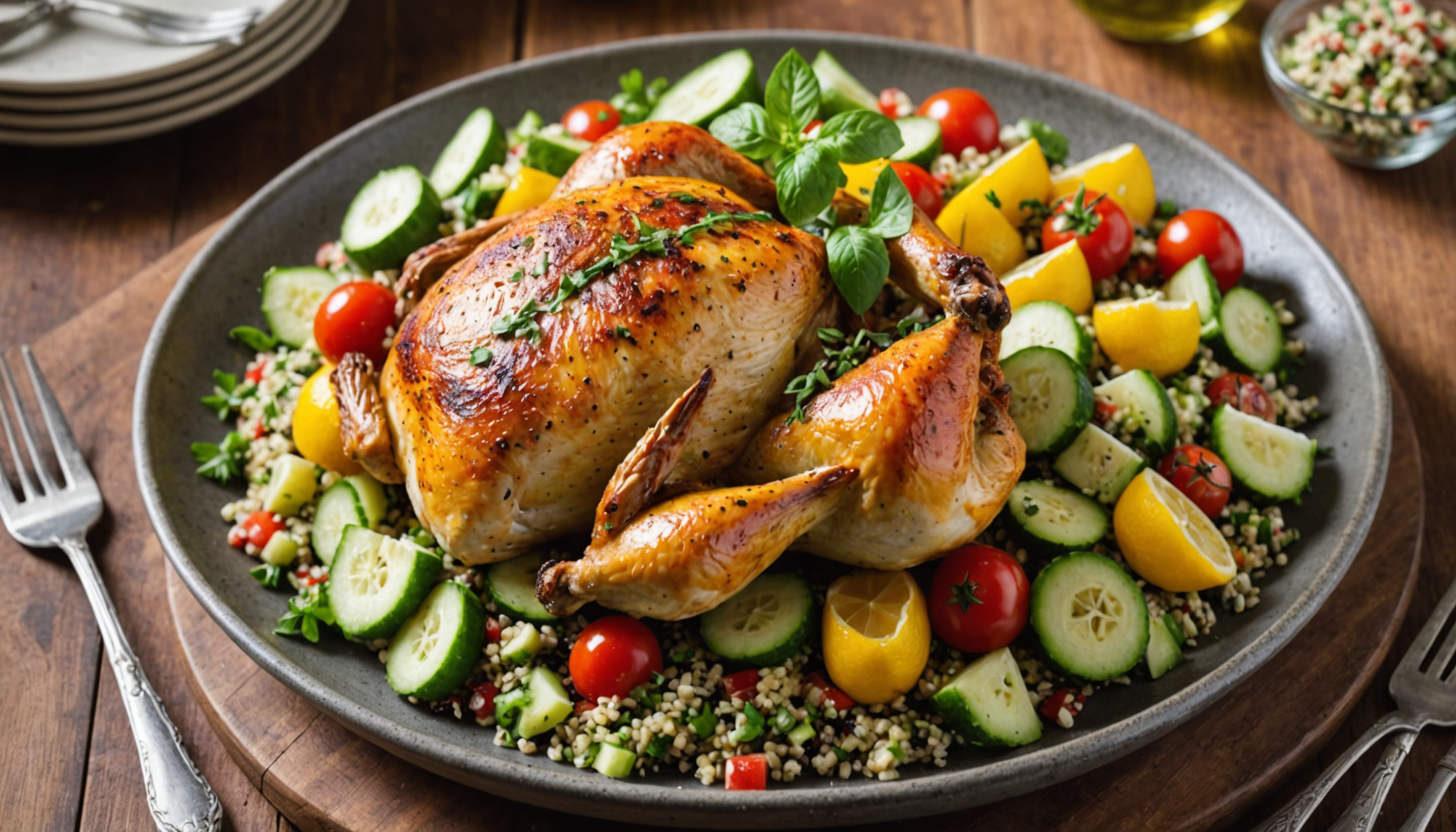 Having a family dinner that satisfies everyone’s taste while promoting anti-inflammatory health can be a delightful challenge that strengthens your family’s bond over nutritious meals. Emphasizing clean eating principles during dinnertime means focusing on whole foods and fresh ingredients that nourish rather than inflame. Start with comforting yet nutritious dishes that utilize wholesome staples like whole grains, lean proteins, and a bounty of vegetables.
Having a family dinner that satisfies everyone’s taste while promoting anti-inflammatory health can be a delightful challenge that strengthens your family’s bond over nutritious meals. Emphasizing clean eating principles during dinnertime means focusing on whole foods and fresh ingredients that nourish rather than inflame. Start with comforting yet nutritious dishes that utilize wholesome staples like whole grains, lean proteins, and a bounty of vegetables.
Consider preparing a zesty lemon-herb roasted chicken. The combination of organic chicken marinated in olive oil, fresh lemon juice, and herbs like rosemary and thyme not only enhances flavor but also supports healthy inflammatory responses. Serve the chicken with a side of quinoa salad, which could include diced cucumbers, cherry tomatoes, bell peppers, and a sprinkle of feta for added flavor. This delightful mix is not only visually appealing but also a powerhouse of nutrients that support your family’s well-being.
For a plant-based option, a hearty lentil and vegetable stew can be a winner. Rich in fiber and protein, lentils are a great addition to an anti-inflammatory diet. Cook them with a variety of rainbow vegetables like carrots, celery, and kale, seasoned with garlic and turmeric. The result is a warm, comforting dish that will leave everyone feeling satisfied while keeping inflammation in check. Serve with crusty whole grain bread for a complete meal that brings everyone to the table.
Another engaging dinner idea is a taco night featuring whole grain tortillas filled with a mix of black beans, sautéed bell peppers, and shredded cabbage. Top them off with avocado and a homemade salsa made from fresh tomatoes, cilantro, and lime juice. Not only do these ingredients meet clean eating standards, but they also offer a delightful array of textures and flavors, making the dining experience enjoyable for both kids and adults alike.
If your family enjoys seafood, a baked salmon dish with garlic and asparagus can work wonders. Salmon, being rich in omega-3 fatty acids, greatly aids in the reduction of inflammation. Pair it with asparagus, which is packed with antioxidants. The beautiful presentation alongside a drizzle of balsamic glaze can turn dinner into a festive occasion that prioritizes health and wellness.
Don’t forget about incorporating rich, seasonal vegetables into your meals! Roasted Brussels sprouts or a medley of seasonal veggies drizzled with olive oil and seasoned with herbs can complement any entree beautifully while boosting their health benefits.
Each of these dinner ideas not only nourishes the body but invites family discussions about the importance of healthy eating. Encouraging your family to talk about the ingredients and their benefits can ignite interest and curiosity about nutrition, making healthy eating a shared journey.
- What are the benefits of an anti-inflammatory diet?
- An anti-inflammatory diet can reduce chronic inflammation, lower the risk of chronic diseases, improve digestive health, and boost overall well-being by promoting the consumption of nutrient-dense foods.
- How can I incorporate anti-inflammatory foods into my family’s meals?
- Incorporate anti-inflammatory foods by focusing on whole grains, fresh fruits and vegetables, healthy fats like olive oil and nuts, and spices such as turmeric and ginger in your cooking and meal planning.
- Are organic ingredients really necessary for an anti-inflammatory diet?
- While not strictly necessary, choosing organic ingredients can minimize exposure to pesticides and additives, making it easier to adhere to clean eating principles, which is beneficial for managing inflammation.
- What are some easy anti-inflammatory dinner recipes?
- Some easy options include quinoa salad with roasted vegetables, lentil stew, baked salmon with asparagus, and vegetable stir-fry with whole grains.
- How can I make my meals more flavorful without adding inflammation?
- Enhance flavors with herbs, spices, garlic, and citrus juices instead of relying on processed sauces and dressings that contain sugars and preservatives which can promote inflammation.
- What snacks are suitable for an anti-inflammatory diet?
- Snack options include nut butter on whole grain toast, raw veggies with hummus, and fresh fruits like berries and apples, all rich in nutrients while keeping inflammation at bay.
- Can children follow an anti-inflammatory diet?
- Yes, children can absolutely follow an anti-inflammatory diet. It promotes healthy eating habits and can be tailored to suit their tastes, incorporating a variety of colorful, nutrient-dense foods that provide essential nutrients.
Light Snacks and Desserts to Satisfy Cravings

Light snacks and desserts can be a delightful way to satisfy cravings while adhering to an anti-inflammatory and clean eating lifestyle. With the right choices, it’s entirely possible to whip up delicious treats that not only pamper your taste buds but also align with your health goals. Whether you’re snacking between meals or indulging after dinner, focus on incorporating organic ingredients that bolster your body’s fight against inflammation.
First, consider making energy bites using dates as a base. These natural sweeteners are high in fiber and help maintain your energy levels throughout the day. Combine pitted dates with nuts such as walnuts or almonds for added crunch and omega-3 fatty acids, and incorporate seeds like chia or flaxseeds to amplify their nutritional profile. Blend all ingredients together, roll them into bite-sized balls, and refrigerate. Not only are they delicious, but they are also packed with nutrients that can help reduce inflammation.
For those with a sweet tooth, a homemade chia seed pudding makes for an excellent dessert option. Chia seeds are rich in omega-3s and fiber, and when mixed with a plant-based milk such as almond or coconut milk, they create a creamy texture once soaked overnight. Flavor your pudding with a splash of vanilla extract and a sweetener of your choice like maple syrup or agave, then top with fresh berries for a refreshing, antioxidant-rich finish.
If you crave something baked, consider whipping up a batch of oatmeal cookies using whole rolled oats as a base. Instead of refined sugars, use mashed bananas or applesauce to sweeten while still adhering to clean eating principles. Add in anti-inflammatory spices such as cinnamon or ginger for both flavor and health benefits. Throw in some dark chocolate chips, which are known for their high antioxidant content, and you have yourself a guilt-free treat that your whole family will enjoy.
As you shop for ingredients, emphasize organic options whenever possible, particularly with fruits and vegetables that are part of your snacks and desserts. Items like strawberries, blueberries, and avocados are not only delicious but also work wonders in combating inflammation. When browsing online grocery stores or local markets, check for certifications and steer clear of additives. Reading labels can help ensure that you’re not unintentionally consuming preservatives or unnecessary sugars, which can contribute to inflammation.
When purchasing nuts, look for options that are raw or dry-roasted without added oils or salt. This way, you enjoy their health benefits without unnecessary additives that may go against your clean eating goals. Additionally, many supermarkets now offer bulk sections, allowing you to buy just what you need without overspending or opting for items that come in processed packaging.
Lastly, don’t shy away from incorporating spices and herbs into your snacks and desserts. Elements like turmeric, ginger, and cinnamon are flavorful additions that come with their anti-inflammatory properties. Consider a simple turmeric latte made with warm almond milk, a splash of vanilla, and a sprinkle of cinnamon to satisfy that evening craving for something sweet yet wholesome.
By making conscious choices in your selection of snacks and desserts, you can maintain a healthy and enlightening relationship with food, all while ensuring that you’re doing your body justice in the fight against inflammation. Happy snacking!
New Customers Offer!
Free Gift for the new customer
$24 Value, When You Subscrib Visit Thrive Market
